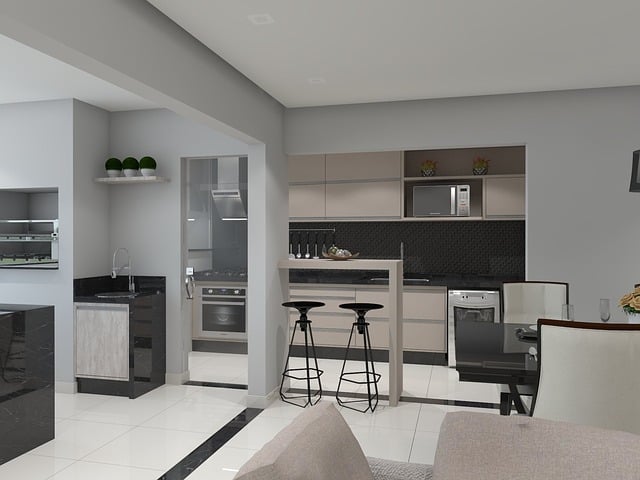Upgrading your kitchen with double-pane or low-emissivity (low-E) glass windows is a strategic move towards energy efficiency and sustainability. These types of glass offer superior insulation, maintaining indoor temperatures year-round, which reduces heating and cooling costs. Low-E glass's special coating reflects infrared radiation, improving temperature regulation and making kitchen appliances more efficient. Combining these upgrades with LED lighting creates an eco-friendly space that saves on energy bills and contributes to a smaller carbon footprint. This comprehensive approach integrates well with other green kitchen design choices, positioning your kitchen as a model of modern, sustainable living.
Upgrading your kitchen with double-pane or low-emissivity (low-E) glass is a powerful step towards an energy-efficient and sustainable home. This article explores the transformative benefits of these upgrades in the context of kitchen remodels, focusing on improved insulation, reduced energy consumption, and a smaller carbon footprint. From eco-friendly advantages to integrating energy-saving appliances, discover how to design a green kitchen that combines style with sustainability.
Understanding the Benefits of Double-Pane and Low-E Glass in Kitchen Remodels
Upgrading your kitchen with double-pane or low-emissivity (low-E) glass can significantly enhance both its aesthetic appeal and energy efficiency. These types of glass are designed to provide excellent insulation, keeping heat in during colder months and preventing excessive cooling in summer, which translates into lower energy bills. In the context of a kitchen remodel, this means you can achieve a more comfortable cooking environment while also contributing to a sustainable and eco-friendly home.
Low-E glass is particularly effective at reducing heat transfer due to its special coating that reflects infrared radiation. This not only improves insulation but also helps in managing indoor temperatures, making your kitchen appliances—including energy-saving models—work more efficiently. Additionally, low-E glass can be paired with other green kitchen upgrades like LED lighting to create a well-rounded, energy-efficient space.
How These Upgrades Improve Energy Efficiency in Kitchens
Upgrading windows to double-pane or low-emissivity glass is a significant step in enhancing the energy efficiency of your kitchen, a space that demands optimal insulation due to its high energy usage potential. These upgrades act as a barrier against temperature variances, preventing heat loss during winter and keeping the cool air in during summer. Double-pane windows, with their air pockets, offer superior insulation compared to single-pane ones, significantly reducing heat transfer and thus lowering heating and cooling costs.
Moreover, incorporating low-emissivity (low-e) glass further improves energy efficiency by reflecting infrared radiation back into the room. This is particularly beneficial in kitchens, where tasks like cooking and cleaning generate significant heat. By minimizing heat transfer through windows, these upgrades contribute to a more balanced indoor temperature, reducing the workload on energy-saving kitchen appliances and eco-friendly lighting systems, such as LED lights, which are ideal for both energy-efficient kitchen design and sustainable kitchen renovations.
Eco-Friendly Advantages: Reducing Your Kitchen's Carbon Footprint
Upgrading your kitchen with double-pane or low-emissivity glass is more than just a cosmetic change; it’s an eco-friendly move that significantly reduces your home’s carbon footprint. These energy-efficient windows play a pivotal role in creating a sustainable kitchen environment, especially when combined with other green kitchen upgrades. By trapping heat during colder months and keeping the cool air inside during warmer ones, these windows lower energy consumption for heating and cooling, directly contributing to reduced greenhouse gas emissions.
Imagine the positive impact on your kitchen’s energy efficiency: less reliance on carbon-intensive energy sources means a smaller carbon footprint. Moreover, integrating low-energy lighting solutions, such as LED fixtures, alongside these upgraded windows amplifies the environmental benefits. This comprehensive approach to kitchen remodel for energy efficiency not only lowers utility bills but also positions your space as a shining example of modern, eco-friendly design within the broader context of sustainable kitchen renovation.
Integrating Energy-Saving Appliances with Insulating Glass for Maximum Effectiveness
When planning a kitchen remodel focused on energy efficiency, integrating energy-saving appliances with insulating glass is a powerful strategy to enhance overall performance. Upgrading to double-pane or low-emissivity (low-e) glass windows not only improves insulation but also creates an ideal environment for eco-friendly kitchen upgrades. This combination significantly reduces heat loss during colder months and keeps the kitchen cool in summer, thereby lowering energy consumption.
Consider swapping outdated appliances with energy-efficient models, such as LED lighting fixtures and high-performance refrigerators, to maximize savings. These green kitchen remodeling choices, paired with insulating glass, contribute to a sustainable kitchen renovation, resulting in a comfortable space that’s also kind to the environment and your utility bills.
Designing a Sustainable Kitchen: Lighting Options and Other Green Considerations
When designing a sustainable kitchen through a remodel aimed at enhancing energy efficiency, one of the key areas to consider is lighting. Choosing energy-efficient lighting options like LED fixtures can significantly reduce power consumption while providing ample illumination. Incorporating natural light through larger windows or skylights also minimizes the need for artificial lighting during daylight hours, contributing to lower energy bills and environmental sustainability.
Beyond lighting, eco-friendly kitchen upgrades encompass selecting appliances with high Energy Star ratings, using low-emissivity glass in cabinets to reduce heat transfer, and incorporating green materials such as recycled countertops and bamboo flooring. These choices not only promote a healthier living environment but also align with broader sustainability goals. A well-planned kitchen remodel for energy efficiency can transform your culinary space into a model of eco-friendly design, setting a standard for both functionality and environmental stewardship.
Upgrading your kitchen with double-pane or low-emissivity glass is a powerful step towards an energy-efficient and sustainable space. By combining these window upgrades with energy-saving appliances and smart lighting choices, you can significantly reduce your kitchen’s carbon footprint without compromising style or functionality. A kitchen remodel focused on eco-friendly features like these contributes to a greener home and a more sustainable future.
